Financial Reporting: IFRS, IAS, and Financial Statements
VerifiedAdded on 2020/10/22
|18
|4242
|215
Report
AI Summary
This report provides a comprehensive overview of financial reporting, covering its context, purpose, and the conceptual and regulatory frameworks, including the qualitative characteristics required for reliable financial information. It identifies the main stakeholders of an organization, detailing the benefits of providing financial information to them, and explores the value of financial reporting in meeting organizational objectives and fostering growth. The report examines the main financial statements as per IAS 1, including a case study analysis of Marks and Spencer's financial statements. It differentiates between International Accounting Standards (IAS) and International Financial Reporting Standards (IFRS), highlighting the benefits of IFRS and the varying degrees of compliance across organizations globally. The report concludes with a discussion on the implications of these standards and their impact on financial reporting practices.

INTERNATIONAL
FINANCIAL REPORTING
FINANCIAL REPORTING
Paraphrase This Document
Need a fresh take? Get an instant paraphrase of this document with our AI Paraphraser

TABLE OF CONTENTS
INTRODUCTION...........................................................................................................................3
MAIN BODY...................................................................................................................................3
1. Context and purpose of Financial reporting ...........................................................................3
2. The conceptual and regulatory framework of financial reporting and qualitative
characteristics required for making financial information more reliable....................................4
3. The main stakeholders of an organisation and benefit of providing financial information to
them.............................................................................................................................................5
4. Value of financial reporting for meeting organisational objective and growth .....................7
5. The main financial statements as per IAS 1............................................................................7
6. Two years Financial statements of Marks and Spencer........................................................11
7. Difference between International Accounting standard (IAS) and International financial
reporting standard (IFRS).........................................................................................................13
8. Benefits of IFRS....................................................................................................................13
9. The varying degree of compliance with IFRS by organisation across the world................14
CONCLUSION .............................................................................................................................15
REFERENCES..............................................................................................................................16
APPENDIX....................................................................................................................................18
INTRODUCTION...........................................................................................................................3
MAIN BODY...................................................................................................................................3
1. Context and purpose of Financial reporting ...........................................................................3
2. The conceptual and regulatory framework of financial reporting and qualitative
characteristics required for making financial information more reliable....................................4
3. The main stakeholders of an organisation and benefit of providing financial information to
them.............................................................................................................................................5
4. Value of financial reporting for meeting organisational objective and growth .....................7
5. The main financial statements as per IAS 1............................................................................7
6. Two years Financial statements of Marks and Spencer........................................................11
7. Difference between International Accounting standard (IAS) and International financial
reporting standard (IFRS).........................................................................................................13
8. Benefits of IFRS....................................................................................................................13
9. The varying degree of compliance with IFRS by organisation across the world................14
CONCLUSION .............................................................................................................................15
REFERENCES..............................................................................................................................16
APPENDIX....................................................................................................................................18
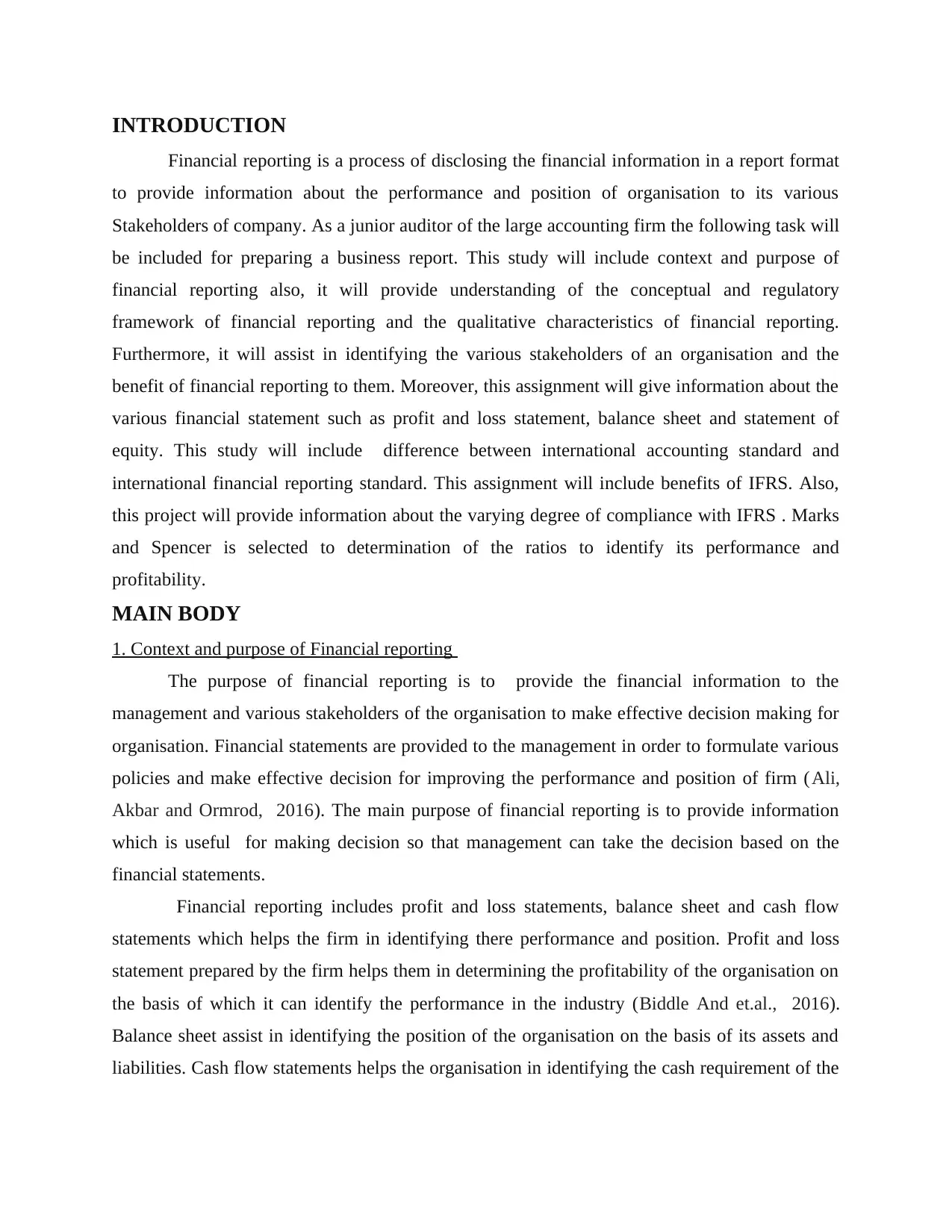
INTRODUCTION
Financial reporting is a process of disclosing the financial information in a report format
to provide information about the performance and position of organisation to its various
Stakeholders of company. As a junior auditor of the large accounting firm the following task will
be included for preparing a business report. This study will include context and purpose of
financial reporting also, it will provide understanding of the conceptual and regulatory
framework of financial reporting and the qualitative characteristics of financial reporting.
Furthermore, it will assist in identifying the various stakeholders of an organisation and the
benefit of financial reporting to them. Moreover, this assignment will give information about the
various financial statement such as profit and loss statement, balance sheet and statement of
equity. This study will include difference between international accounting standard and
international financial reporting standard. This assignment will include benefits of IFRS. Also,
this project will provide information about the varying degree of compliance with IFRS . Marks
and Spencer is selected to determination of the ratios to identify its performance and
profitability.
MAIN BODY
1. Context and purpose of Financial reporting
The purpose of financial reporting is to provide the financial information to the
management and various stakeholders of the organisation to make effective decision making for
organisation. Financial statements are provided to the management in order to formulate various
policies and make effective decision for improving the performance and position of firm (Ali,
Akbar and Ormrod, 2016). The main purpose of financial reporting is to provide information
which is useful for making decision so that management can take the decision based on the
financial statements.
Financial reporting includes profit and loss statements, balance sheet and cash flow
statements which helps the firm in identifying there performance and position. Profit and loss
statement prepared by the firm helps them in determining the profitability of the organisation on
the basis of which it can identify the performance in the industry (Biddle And et.al., 2016).
Balance sheet assist in identifying the position of the organisation on the basis of its assets and
liabilities. Cash flow statements helps the organisation in identifying the cash requirement of the
Financial reporting is a process of disclosing the financial information in a report format
to provide information about the performance and position of organisation to its various
Stakeholders of company. As a junior auditor of the large accounting firm the following task will
be included for preparing a business report. This study will include context and purpose of
financial reporting also, it will provide understanding of the conceptual and regulatory
framework of financial reporting and the qualitative characteristics of financial reporting.
Furthermore, it will assist in identifying the various stakeholders of an organisation and the
benefit of financial reporting to them. Moreover, this assignment will give information about the
various financial statement such as profit and loss statement, balance sheet and statement of
equity. This study will include difference between international accounting standard and
international financial reporting standard. This assignment will include benefits of IFRS. Also,
this project will provide information about the varying degree of compliance with IFRS . Marks
and Spencer is selected to determination of the ratios to identify its performance and
profitability.
MAIN BODY
1. Context and purpose of Financial reporting
The purpose of financial reporting is to provide the financial information to the
management and various stakeholders of the organisation to make effective decision making for
organisation. Financial statements are provided to the management in order to formulate various
policies and make effective decision for improving the performance and position of firm (Ali,
Akbar and Ormrod, 2016). The main purpose of financial reporting is to provide information
which is useful for making decision so that management can take the decision based on the
financial statements.
Financial reporting includes profit and loss statements, balance sheet and cash flow
statements which helps the firm in identifying there performance and position. Profit and loss
statement prepared by the firm helps them in determining the profitability of the organisation on
the basis of which it can identify the performance in the industry (Biddle And et.al., 2016).
Balance sheet assist in identifying the position of the organisation on the basis of its assets and
liabilities. Cash flow statements helps the organisation in identifying the cash requirement of the
⊘ This is a preview!⊘
Do you want full access?
Subscribe today to unlock all pages.

Trusted by 1+ million students worldwide
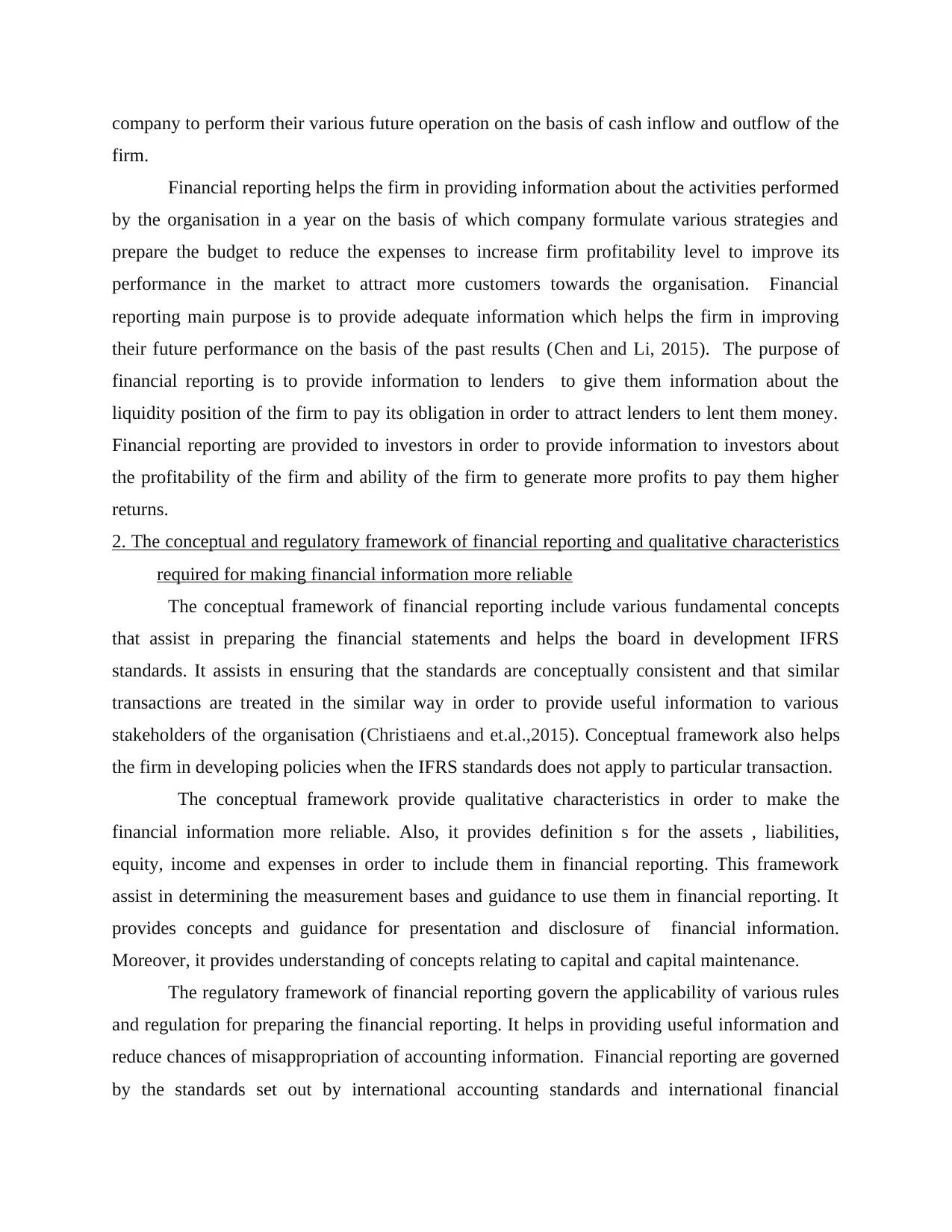
company to perform their various future operation on the basis of cash inflow and outflow of the
firm.
Financial reporting helps the firm in providing information about the activities performed
by the organisation in a year on the basis of which company formulate various strategies and
prepare the budget to reduce the expenses to increase firm profitability level to improve its
performance in the market to attract more customers towards the organisation. Financial
reporting main purpose is to provide adequate information which helps the firm in improving
their future performance on the basis of the past results (Chen and Li, 2015). The purpose of
financial reporting is to provide information to lenders to give them information about the
liquidity position of the firm to pay its obligation in order to attract lenders to lent them money.
Financial reporting are provided to investors in order to provide information to investors about
the profitability of the firm and ability of the firm to generate more profits to pay them higher
returns.
2. The conceptual and regulatory framework of financial reporting and qualitative characteristics
required for making financial information more reliable
The conceptual framework of financial reporting include various fundamental concepts
that assist in preparing the financial statements and helps the board in development IFRS
standards. It assists in ensuring that the standards are conceptually consistent and that similar
transactions are treated in the similar way in order to provide useful information to various
stakeholders of the organisation (Christiaens and et.al.,2015). Conceptual framework also helps
the firm in developing policies when the IFRS standards does not apply to particular transaction.
The conceptual framework provide qualitative characteristics in order to make the
financial information more reliable. Also, it provides definition s for the assets , liabilities,
equity, income and expenses in order to include them in financial reporting. This framework
assist in determining the measurement bases and guidance to use them in financial reporting. It
provides concepts and guidance for presentation and disclosure of financial information.
Moreover, it provides understanding of concepts relating to capital and capital maintenance.
The regulatory framework of financial reporting govern the applicability of various rules
and regulation for preparing the financial reporting. It helps in providing useful information and
reduce chances of misappropriation of accounting information. Financial reporting are governed
by the standards set out by international accounting standards and international financial
firm.
Financial reporting helps the firm in providing information about the activities performed
by the organisation in a year on the basis of which company formulate various strategies and
prepare the budget to reduce the expenses to increase firm profitability level to improve its
performance in the market to attract more customers towards the organisation. Financial
reporting main purpose is to provide adequate information which helps the firm in improving
their future performance on the basis of the past results (Chen and Li, 2015). The purpose of
financial reporting is to provide information to lenders to give them information about the
liquidity position of the firm to pay its obligation in order to attract lenders to lent them money.
Financial reporting are provided to investors in order to provide information to investors about
the profitability of the firm and ability of the firm to generate more profits to pay them higher
returns.
2. The conceptual and regulatory framework of financial reporting and qualitative characteristics
required for making financial information more reliable
The conceptual framework of financial reporting include various fundamental concepts
that assist in preparing the financial statements and helps the board in development IFRS
standards. It assists in ensuring that the standards are conceptually consistent and that similar
transactions are treated in the similar way in order to provide useful information to various
stakeholders of the organisation (Christiaens and et.al.,2015). Conceptual framework also helps
the firm in developing policies when the IFRS standards does not apply to particular transaction.
The conceptual framework provide qualitative characteristics in order to make the
financial information more reliable. Also, it provides definition s for the assets , liabilities,
equity, income and expenses in order to include them in financial reporting. This framework
assist in determining the measurement bases and guidance to use them in financial reporting. It
provides concepts and guidance for presentation and disclosure of financial information.
Moreover, it provides understanding of concepts relating to capital and capital maintenance.
The regulatory framework of financial reporting govern the applicability of various rules
and regulation for preparing the financial reporting. It helps in providing useful information and
reduce chances of misappropriation of accounting information. Financial reporting are governed
by the standards set out by international accounting standards and international financial
Paraphrase This Document
Need a fresh take? Get an instant paraphrase of this document with our AI Paraphraser
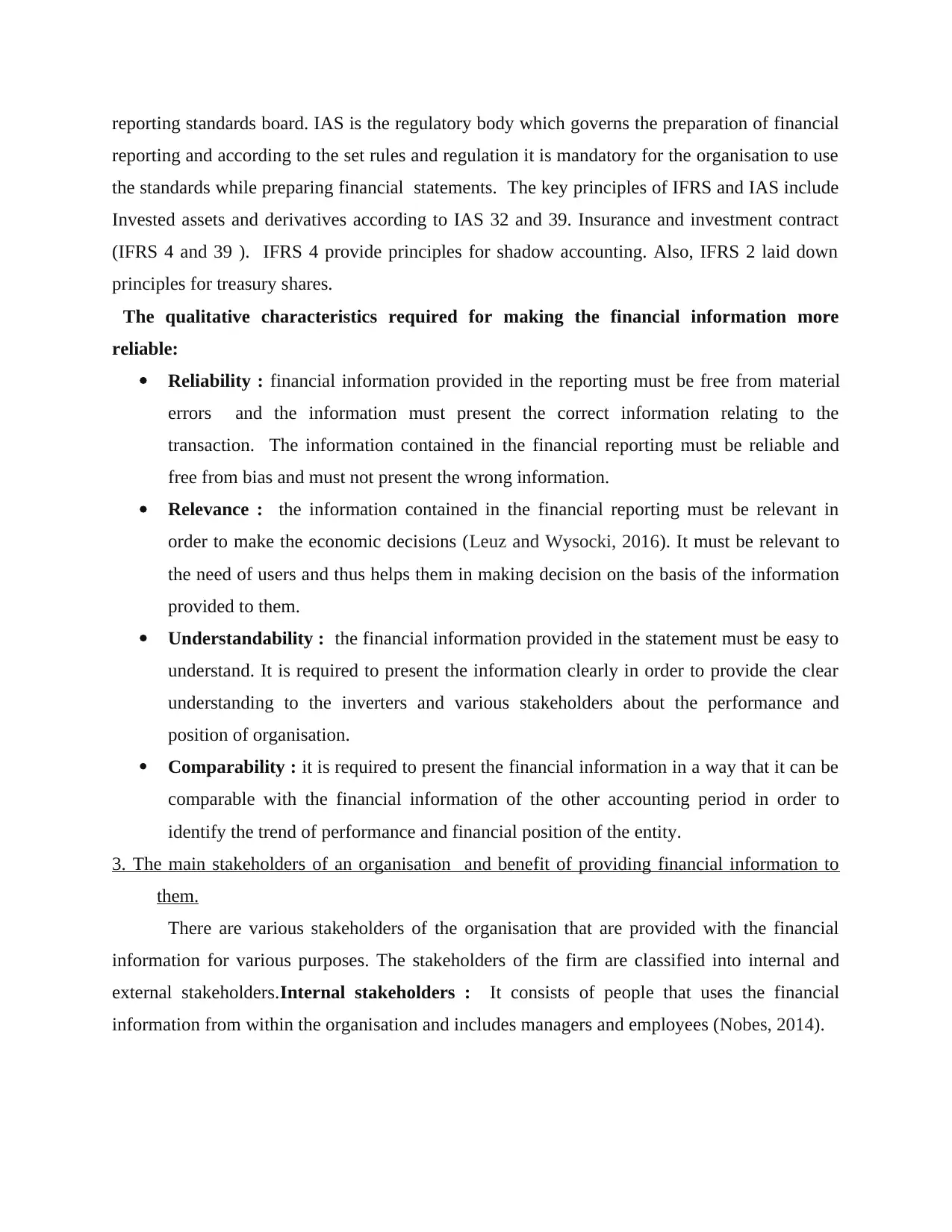
reporting standards board. IAS is the regulatory body which governs the preparation of financial
reporting and according to the set rules and regulation it is mandatory for the organisation to use
the standards while preparing financial statements. The key principles of IFRS and IAS include
Invested assets and derivatives according to IAS 32 and 39. Insurance and investment contract
(IFRS 4 and 39 ). IFRS 4 provide principles for shadow accounting. Also, IFRS 2 laid down
principles for treasury shares.
The qualitative characteristics required for making the financial information more
reliable:
Reliability : financial information provided in the reporting must be free from material
errors and the information must present the correct information relating to the
transaction. The information contained in the financial reporting must be reliable and
free from bias and must not present the wrong information.
Relevance : the information contained in the financial reporting must be relevant in
order to make the economic decisions (Leuz and Wysocki, 2016). It must be relevant to
the need of users and thus helps them in making decision on the basis of the information
provided to them.
Understandability : the financial information provided in the statement must be easy to
understand. It is required to present the information clearly in order to provide the clear
understanding to the inverters and various stakeholders about the performance and
position of organisation.
Comparability : it is required to present the financial information in a way that it can be
comparable with the financial information of the other accounting period in order to
identify the trend of performance and financial position of the entity.
3. The main stakeholders of an organisation and benefit of providing financial information to
them.
There are various stakeholders of the organisation that are provided with the financial
information for various purposes. The stakeholders of the firm are classified into internal and
external stakeholders.Internal stakeholders : It consists of people that uses the financial
information from within the organisation and includes managers and employees (Nobes, 2014).
reporting and according to the set rules and regulation it is mandatory for the organisation to use
the standards while preparing financial statements. The key principles of IFRS and IAS include
Invested assets and derivatives according to IAS 32 and 39. Insurance and investment contract
(IFRS 4 and 39 ). IFRS 4 provide principles for shadow accounting. Also, IFRS 2 laid down
principles for treasury shares.
The qualitative characteristics required for making the financial information more
reliable:
Reliability : financial information provided in the reporting must be free from material
errors and the information must present the correct information relating to the
transaction. The information contained in the financial reporting must be reliable and
free from bias and must not present the wrong information.
Relevance : the information contained in the financial reporting must be relevant in
order to make the economic decisions (Leuz and Wysocki, 2016). It must be relevant to
the need of users and thus helps them in making decision on the basis of the information
provided to them.
Understandability : the financial information provided in the statement must be easy to
understand. It is required to present the information clearly in order to provide the clear
understanding to the inverters and various stakeholders about the performance and
position of organisation.
Comparability : it is required to present the financial information in a way that it can be
comparable with the financial information of the other accounting period in order to
identify the trend of performance and financial position of the entity.
3. The main stakeholders of an organisation and benefit of providing financial information to
them.
There are various stakeholders of the organisation that are provided with the financial
information for various purposes. The stakeholders of the firm are classified into internal and
external stakeholders.Internal stakeholders : It consists of people that uses the financial
information from within the organisation and includes managers and employees (Nobes, 2014).

Managers : managers are the internal stakeholders of the organisation and provided with
the financial information for various purposes such as for decision making, planning , controlling
etc. managers use the financial information for decision making to improve future performance.
Employees : they are provided with the financial information to provide them
understanding about the performance and position of the organisation for their future prospects
and to compare the performance of the firm with other organisations.
External stakeholder : it consists of people that are provided by the information which
are outside the organisation but uses the information for various reasons.
Investors : The financial information of the company is provided to the investors in order
to provide them understanding of the profitability of the firm in which they have invested their
money (Lang and Stice-Lawrence, 2015). Investors are the users of financial statements as it
helps them in determining the return on the capital invested.
Lenders : lenders are the people that lent money to the organisation for running their
business activities. Lenders uses the financial data for identifying the liquidity position of the
organisation in order to get the repayment of money lent by them to the organisation.
Suppliers : These are the people that supply raw material to the organisation for their
products and services. The financial information is provided to them in order to provide them
understanding about the future growth and performance of organisation.
Customers : they are provided the financial information in order to give understanding to
them about the performance and position of the firm in the market to attract more customers
towards the organisation (Users of Financial statements, 2017). Government : financial
information helps the government in identifying the tax liability of the organisation to determine
if proper tax are paid by them or not and also helps the government in formulating various
policies for the economic development etc.
Competitors : the information is provided to the competitors to inform them about the
strategies followed by organisation and to compare their performance with the firm to grow their
business.
Benefits of providing financial information
Financial information helps the users in determining profitability of the firm which helps
in identifying the performance.
the financial information for various purposes such as for decision making, planning , controlling
etc. managers use the financial information for decision making to improve future performance.
Employees : they are provided with the financial information to provide them
understanding about the performance and position of the organisation for their future prospects
and to compare the performance of the firm with other organisations.
External stakeholder : it consists of people that are provided by the information which
are outside the organisation but uses the information for various reasons.
Investors : The financial information of the company is provided to the investors in order
to provide them understanding of the profitability of the firm in which they have invested their
money (Lang and Stice-Lawrence, 2015). Investors are the users of financial statements as it
helps them in determining the return on the capital invested.
Lenders : lenders are the people that lent money to the organisation for running their
business activities. Lenders uses the financial data for identifying the liquidity position of the
organisation in order to get the repayment of money lent by them to the organisation.
Suppliers : These are the people that supply raw material to the organisation for their
products and services. The financial information is provided to them in order to provide them
understanding about the future growth and performance of organisation.
Customers : they are provided the financial information in order to give understanding to
them about the performance and position of the firm in the market to attract more customers
towards the organisation (Users of Financial statements, 2017). Government : financial
information helps the government in identifying the tax liability of the organisation to determine
if proper tax are paid by them or not and also helps the government in formulating various
policies for the economic development etc.
Competitors : the information is provided to the competitors to inform them about the
strategies followed by organisation and to compare their performance with the firm to grow their
business.
Benefits of providing financial information
Financial information helps the users in determining profitability of the firm which helps
in identifying the performance.
⊘ This is a preview!⊘
Do you want full access?
Subscribe today to unlock all pages.

Trusted by 1+ million students worldwide
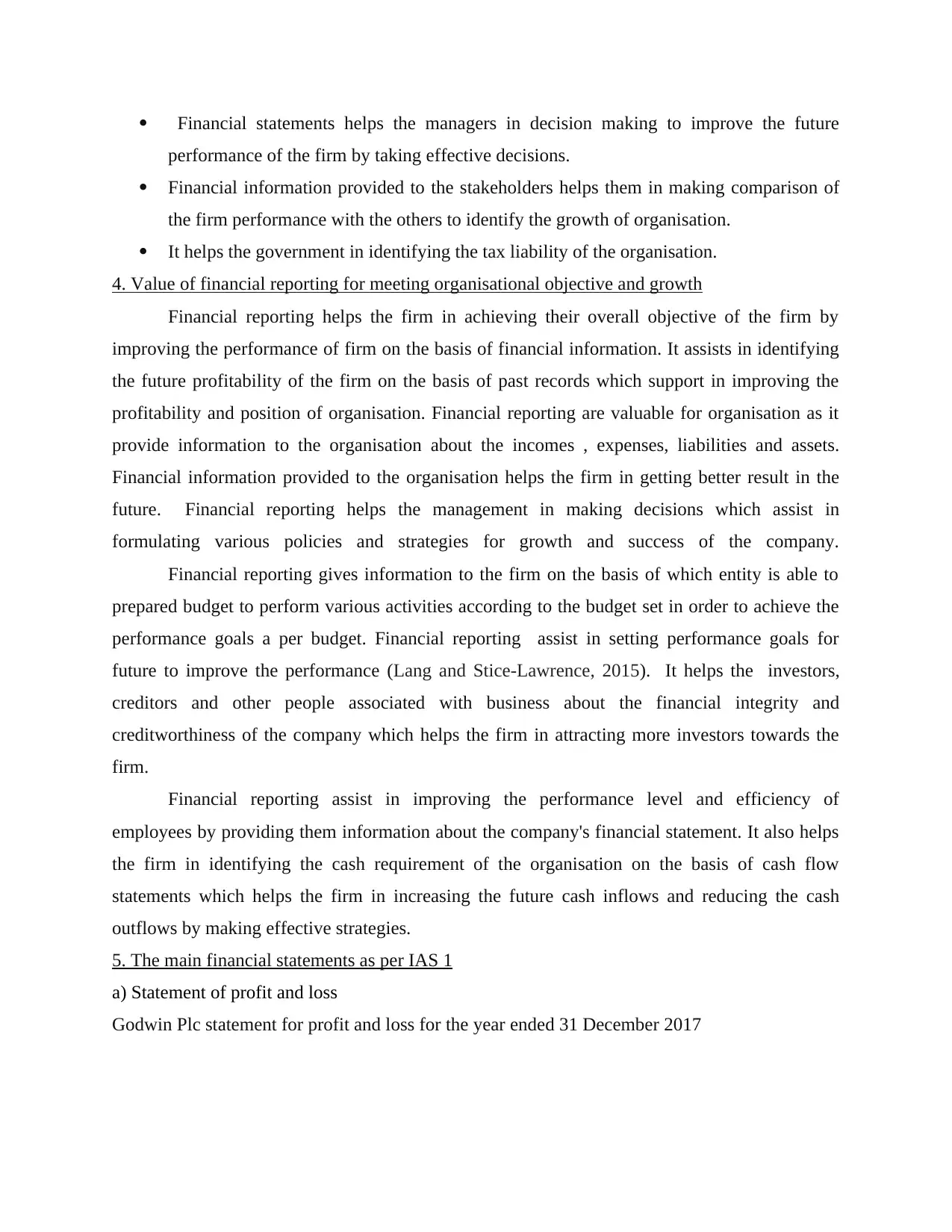
Financial statements helps the managers in decision making to improve the future
performance of the firm by taking effective decisions.
Financial information provided to the stakeholders helps them in making comparison of
the firm performance with the others to identify the growth of organisation.
It helps the government in identifying the tax liability of the organisation.
4. Value of financial reporting for meeting organisational objective and growth
Financial reporting helps the firm in achieving their overall objective of the firm by
improving the performance of firm on the basis of financial information. It assists in identifying
the future profitability of the firm on the basis of past records which support in improving the
profitability and position of organisation. Financial reporting are valuable for organisation as it
provide information to the organisation about the incomes , expenses, liabilities and assets.
Financial information provided to the organisation helps the firm in getting better result in the
future. Financial reporting helps the management in making decisions which assist in
formulating various policies and strategies for growth and success of the company.
Financial reporting gives information to the firm on the basis of which entity is able to
prepared budget to perform various activities according to the budget set in order to achieve the
performance goals a per budget. Financial reporting assist in setting performance goals for
future to improve the performance (Lang and Stice-Lawrence, 2015). It helps the investors,
creditors and other people associated with business about the financial integrity and
creditworthiness of the company which helps the firm in attracting more investors towards the
firm.
Financial reporting assist in improving the performance level and efficiency of
employees by providing them information about the company's financial statement. It also helps
the firm in identifying the cash requirement of the organisation on the basis of cash flow
statements which helps the firm in increasing the future cash inflows and reducing the cash
outflows by making effective strategies.
5. The main financial statements as per IAS 1
a) Statement of profit and loss
Godwin Plc statement for profit and loss for the year ended 31 December 2017
performance of the firm by taking effective decisions.
Financial information provided to the stakeholders helps them in making comparison of
the firm performance with the others to identify the growth of organisation.
It helps the government in identifying the tax liability of the organisation.
4. Value of financial reporting for meeting organisational objective and growth
Financial reporting helps the firm in achieving their overall objective of the firm by
improving the performance of firm on the basis of financial information. It assists in identifying
the future profitability of the firm on the basis of past records which support in improving the
profitability and position of organisation. Financial reporting are valuable for organisation as it
provide information to the organisation about the incomes , expenses, liabilities and assets.
Financial information provided to the organisation helps the firm in getting better result in the
future. Financial reporting helps the management in making decisions which assist in
formulating various policies and strategies for growth and success of the company.
Financial reporting gives information to the firm on the basis of which entity is able to
prepared budget to perform various activities according to the budget set in order to achieve the
performance goals a per budget. Financial reporting assist in setting performance goals for
future to improve the performance (Lang and Stice-Lawrence, 2015). It helps the investors,
creditors and other people associated with business about the financial integrity and
creditworthiness of the company which helps the firm in attracting more investors towards the
firm.
Financial reporting assist in improving the performance level and efficiency of
employees by providing them information about the company's financial statement. It also helps
the firm in identifying the cash requirement of the organisation on the basis of cash flow
statements which helps the firm in increasing the future cash inflows and reducing the cash
outflows by making effective strategies.
5. The main financial statements as per IAS 1
a) Statement of profit and loss
Godwin Plc statement for profit and loss for the year ended 31 December 2017
Paraphrase This Document
Need a fresh take? Get an instant paraphrase of this document with our AI Paraphraser

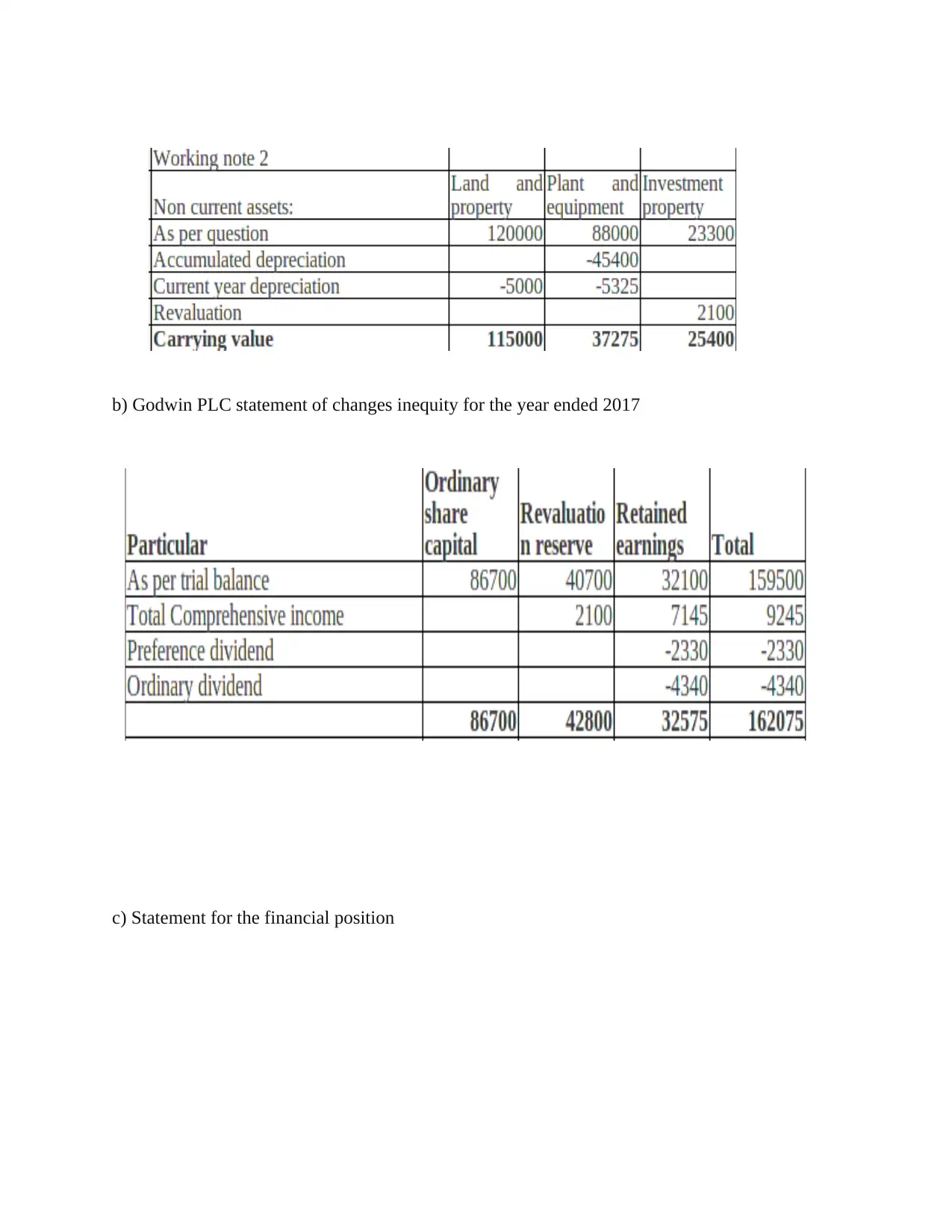
b) Godwin PLC statement of changes inequity for the year ended 2017
c) Statement for the financial position
c) Statement for the financial position
⊘ This is a preview!⊘
Do you want full access?
Subscribe today to unlock all pages.

Trusted by 1+ million students worldwide
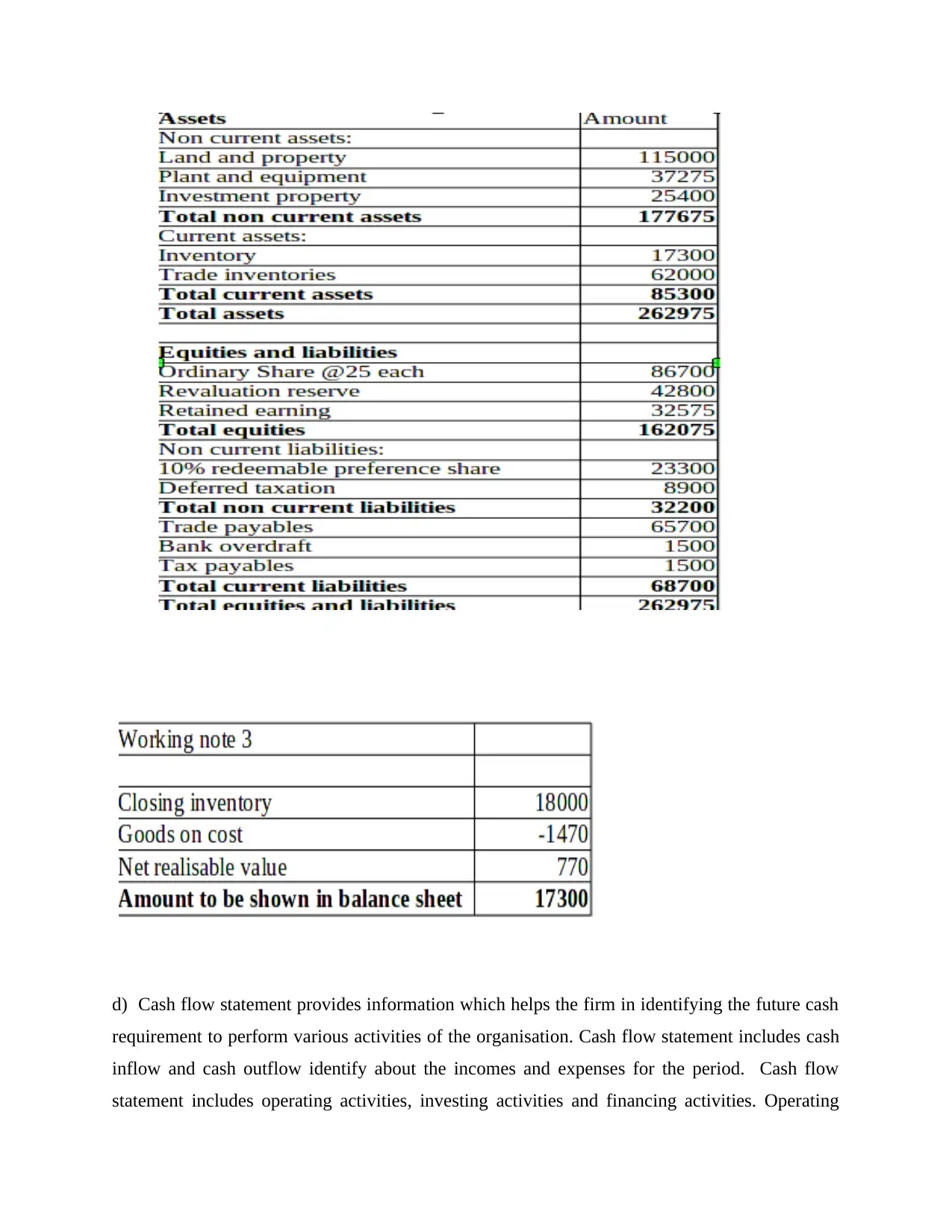
d) Cash flow statement provides information which helps the firm in identifying the future cash
requirement to perform various activities of the organisation. Cash flow statement includes cash
inflow and cash outflow identify about the incomes and expenses for the period. Cash flow
statement includes operating activities, investing activities and financing activities. Operating
requirement to perform various activities of the organisation. Cash flow statement includes cash
inflow and cash outflow identify about the incomes and expenses for the period. Cash flow
statement includes operating activities, investing activities and financing activities. Operating
Paraphrase This Document
Need a fresh take? Get an instant paraphrase of this document with our AI Paraphraser
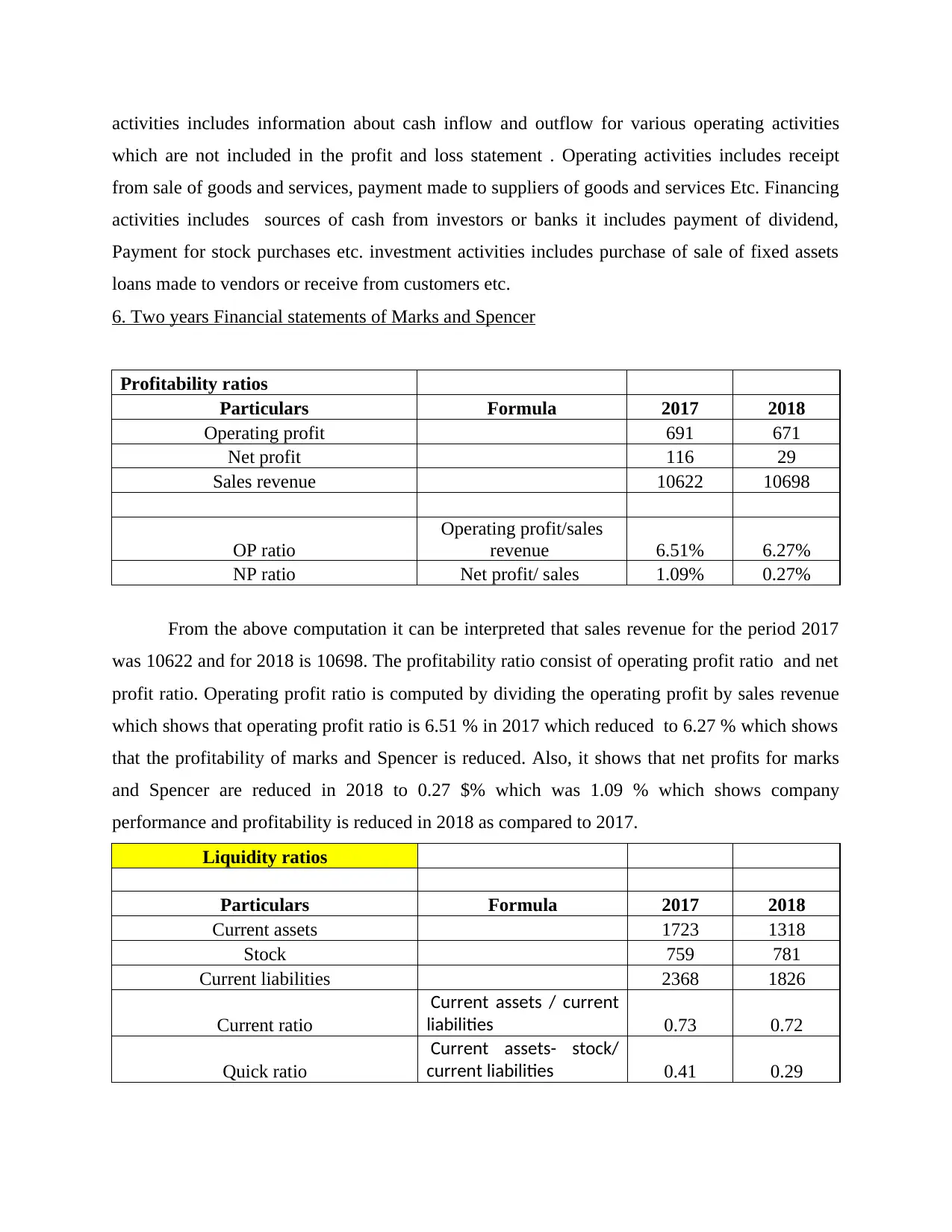
activities includes information about cash inflow and outflow for various operating activities
which are not included in the profit and loss statement . Operating activities includes receipt
from sale of goods and services, payment made to suppliers of goods and services Etc. Financing
activities includes sources of cash from investors or banks it includes payment of dividend,
Payment for stock purchases etc. investment activities includes purchase of sale of fixed assets
loans made to vendors or receive from customers etc.
6. Two years Financial statements of Marks and Spencer
Profitability ratios
Particulars Formula 2017 2018
Operating profit 691 671
Net profit 116 29
Sales revenue 10622 10698
OP ratio
Operating profit/sales
revenue 6.51% 6.27%
NP ratio Net profit/ sales 1.09% 0.27%
From the above computation it can be interpreted that sales revenue for the period 2017
was 10622 and for 2018 is 10698. The profitability ratio consist of operating profit ratio and net
profit ratio. Operating profit ratio is computed by dividing the operating profit by sales revenue
which shows that operating profit ratio is 6.51 % in 2017 which reduced to 6.27 % which shows
that the profitability of marks and Spencer is reduced. Also, it shows that net profits for marks
and Spencer are reduced in 2018 to 0.27 $% which was 1.09 % which shows company
performance and profitability is reduced in 2018 as compared to 2017.
Liquidity ratios
Particulars Formula 2017 2018
Current assets 1723 1318
Stock 759 781
Current liabilities 2368 1826
Current ratio
Current assets / current
liabilities 0.73 0.72
Quick ratio
Current assets- stock/
current liabilities 0.41 0.29
which are not included in the profit and loss statement . Operating activities includes receipt
from sale of goods and services, payment made to suppliers of goods and services Etc. Financing
activities includes sources of cash from investors or banks it includes payment of dividend,
Payment for stock purchases etc. investment activities includes purchase of sale of fixed assets
loans made to vendors or receive from customers etc.
6. Two years Financial statements of Marks and Spencer
Profitability ratios
Particulars Formula 2017 2018
Operating profit 691 671
Net profit 116 29
Sales revenue 10622 10698
OP ratio
Operating profit/sales
revenue 6.51% 6.27%
NP ratio Net profit/ sales 1.09% 0.27%
From the above computation it can be interpreted that sales revenue for the period 2017
was 10622 and for 2018 is 10698. The profitability ratio consist of operating profit ratio and net
profit ratio. Operating profit ratio is computed by dividing the operating profit by sales revenue
which shows that operating profit ratio is 6.51 % in 2017 which reduced to 6.27 % which shows
that the profitability of marks and Spencer is reduced. Also, it shows that net profits for marks
and Spencer are reduced in 2018 to 0.27 $% which was 1.09 % which shows company
performance and profitability is reduced in 2018 as compared to 2017.
Liquidity ratios
Particulars Formula 2017 2018
Current assets 1723 1318
Stock 759 781
Current liabilities 2368 1826
Current ratio
Current assets / current
liabilities 0.73 0.72
Quick ratio
Current assets- stock/
current liabilities 0.41 0.29
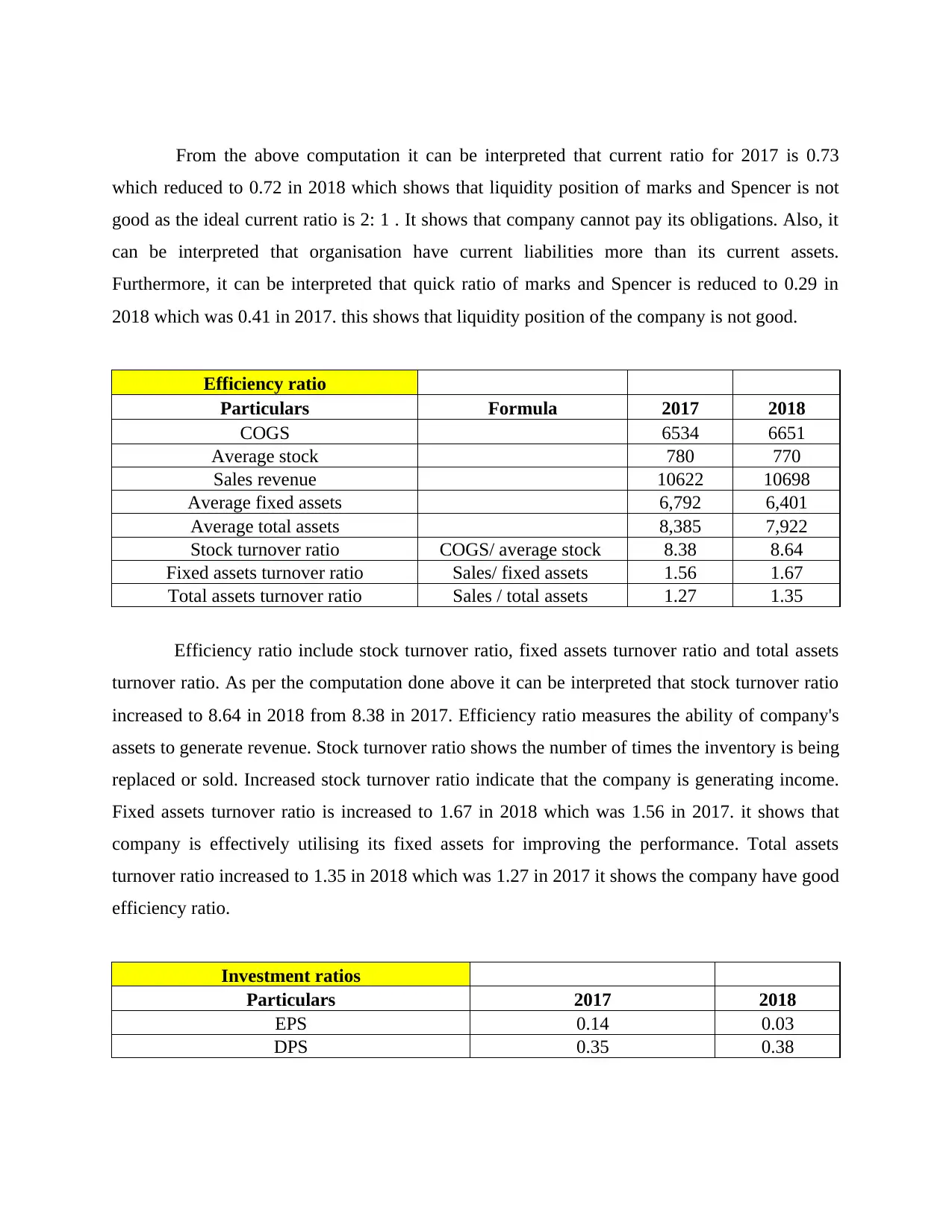
From the above computation it can be interpreted that current ratio for 2017 is 0.73
which reduced to 0.72 in 2018 which shows that liquidity position of marks and Spencer is not
good as the ideal current ratio is 2: 1 . It shows that company cannot pay its obligations. Also, it
can be interpreted that organisation have current liabilities more than its current assets.
Furthermore, it can be interpreted that quick ratio of marks and Spencer is reduced to 0.29 in
2018 which was 0.41 in 2017. this shows that liquidity position of the company is not good.
Efficiency ratio
Particulars Formula 2017 2018
COGS 6534 6651
Average stock 780 770
Sales revenue 10622 10698
Average fixed assets 6,792 6,401
Average total assets 8,385 7,922
Stock turnover ratio COGS/ average stock 8.38 8.64
Fixed assets turnover ratio Sales/ fixed assets 1.56 1.67
Total assets turnover ratio Sales / total assets 1.27 1.35
Efficiency ratio include stock turnover ratio, fixed assets turnover ratio and total assets
turnover ratio. As per the computation done above it can be interpreted that stock turnover ratio
increased to 8.64 in 2018 from 8.38 in 2017. Efficiency ratio measures the ability of company's
assets to generate revenue. Stock turnover ratio shows the number of times the inventory is being
replaced or sold. Increased stock turnover ratio indicate that the company is generating income.
Fixed assets turnover ratio is increased to 1.67 in 2018 which was 1.56 in 2017. it shows that
company is effectively utilising its fixed assets for improving the performance. Total assets
turnover ratio increased to 1.35 in 2018 which was 1.27 in 2017 it shows the company have good
efficiency ratio.
Investment ratios
Particulars 2017 2018
EPS 0.14 0.03
DPS 0.35 0.38
which reduced to 0.72 in 2018 which shows that liquidity position of marks and Spencer is not
good as the ideal current ratio is 2: 1 . It shows that company cannot pay its obligations. Also, it
can be interpreted that organisation have current liabilities more than its current assets.
Furthermore, it can be interpreted that quick ratio of marks and Spencer is reduced to 0.29 in
2018 which was 0.41 in 2017. this shows that liquidity position of the company is not good.
Efficiency ratio
Particulars Formula 2017 2018
COGS 6534 6651
Average stock 780 770
Sales revenue 10622 10698
Average fixed assets 6,792 6,401
Average total assets 8,385 7,922
Stock turnover ratio COGS/ average stock 8.38 8.64
Fixed assets turnover ratio Sales/ fixed assets 1.56 1.67
Total assets turnover ratio Sales / total assets 1.27 1.35
Efficiency ratio include stock turnover ratio, fixed assets turnover ratio and total assets
turnover ratio. As per the computation done above it can be interpreted that stock turnover ratio
increased to 8.64 in 2018 from 8.38 in 2017. Efficiency ratio measures the ability of company's
assets to generate revenue. Stock turnover ratio shows the number of times the inventory is being
replaced or sold. Increased stock turnover ratio indicate that the company is generating income.
Fixed assets turnover ratio is increased to 1.67 in 2018 which was 1.56 in 2017. it shows that
company is effectively utilising its fixed assets for improving the performance. Total assets
turnover ratio increased to 1.35 in 2018 which was 1.27 in 2017 it shows the company have good
efficiency ratio.
Investment ratios
Particulars 2017 2018
EPS 0.14 0.03
DPS 0.35 0.38
⊘ This is a preview!⊘
Do you want full access?
Subscribe today to unlock all pages.

Trusted by 1+ million students worldwide
1 out of 18
Related Documents
Your All-in-One AI-Powered Toolkit for Academic Success.
+13062052269
info@desklib.com
Available 24*7 on WhatsApp / Email
![[object Object]](/_next/static/media/star-bottom.7253800d.svg)
Unlock your academic potential
Copyright © 2020–2025 A2Z Services. All Rights Reserved. Developed and managed by ZUCOL.





